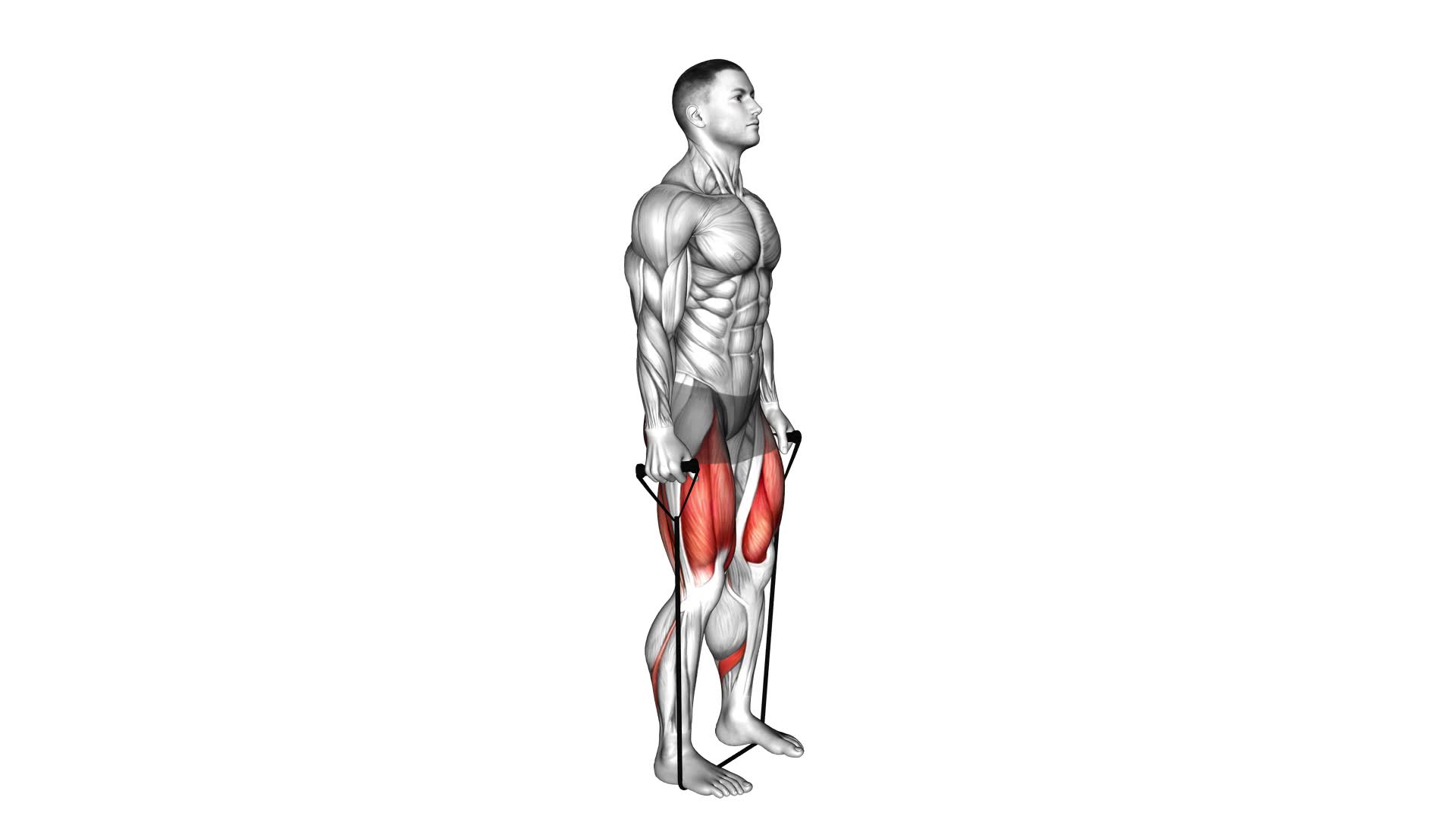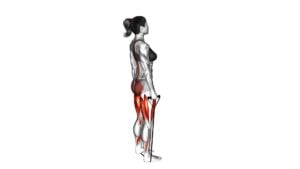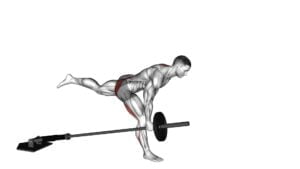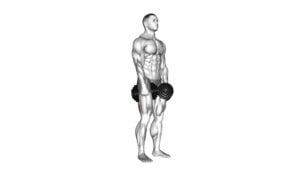Band Straight Back Stiff Leg Deadlift – Video Exercise Guide & Tips

Are you looking for a challenging exercise to strengthen your lower body? Look no further than the Band Straight Back Stiff Leg Deadlift.
Watch This Exercise Video
This video exercise guide will show you the proper form and technique, as well as provide tips for increasing resistance and intensity.
Avoid common mistakes and discover variations for different fitness levels.
Get ready to take your workout to the next level with this effective exercise.
Key Takeaways
- Improves hamstring flexibility
- Strengthens glutes and lower back
- Enhances lower body stability
- Utilizes resistance band for added challenge
Benefits of the Band Straight Back Stiff Leg Deadlift
The band straight back stiff leg deadlift offers numerous benefits for your lower body strength and stability. This exercise is highly effective in improving hamstring flexibility, as it requires a deep stretch in the hamstrings while maintaining a straight back. By using a resistance band, you add an extra challenge to the movement, further enhancing the benefits.
One of the main advantages of the band straight back stiff leg deadlift is the increased glute and lower back strength it provides. As you lift the band, you engage your glutes and lower back muscles to extend your hips and maintain a straight posture. This helps in developing strong and toned glutes, as well as a stable lower back.
Additionally, this exercise also aids in improving overall lower body stability. By performing the movement with a straight back, you activate your core muscles, which play a crucial role in maintaining balance and stability. This can be particularly beneficial for athletes or individuals involved in activities that require a strong and stable lower body.
Proper Form and Technique for the Exercise
Mastering the proper form and technique for the band straight back stiff leg deadlift is crucial for maximizing the benefits of this exercise. To ensure you perform this exercise correctly, it's important to avoid common errors that could lead to injury or ineffective results.
First, maintain a straight back throughout the movement. Keep your core engaged and shoulders pulled back to prevent rounding of the spine. This will ensure proper alignment and target the intended muscle groups effectively.
Another common error is using too much weight. Start with a lighter resistance band and gradually increase the intensity as your strength improves. Using excessive weight can compromise your form and increase the risk of injury.
To perform the exercise, stand with your feet shoulder-width apart, holding the resistance band in front of your thighs. Hinge at the hips, pushing your glutes back while keeping your knees slightly bent. Lower the band towards the ground while maintaining a straight back. Once you reach a comfortable position, squeeze your glutes and hamstrings to return to the starting position.
Tips for Increasing Resistance and Intensity
To increase resistance and intensity, try using a heavier resistance band to challenge your muscles further. Increasing weights is an effective way to promote progressive overload, which is crucial for muscle growth and strength development. By gradually increasing the resistance, you force your muscles to adapt and become stronger over time.
When selecting a heavier resistance band, make sure it still allows you to maintain proper form and technique. It should provide enough resistance to make the exercise challenging, but not so much that it compromises your ability to perform the movement correctly. It's important to find the right balance between intensity and safety.
In addition to using a heavier resistance band, you can also increase the number of repetitions or sets you perform. This will further challenge your muscles and promote muscle growth. However, it's essential to listen to your body and avoid overexertion. Gradually progress by adding more resistance or repetitions over time to avoid injuries and ensure steady progress.
By increasing resistance and intensity, you'll continue to challenge your muscles and stimulate growth. This will help you achieve your fitness goals more effectively.
Now, let's discuss some common mistakes to avoid while performing the Band Straight Back Stiff Leg Deadlift.
Common Mistakes to Avoid While Performing the Exercise
When performing the Band Straight Back Stiff Leg Deadlift, be mindful of common mistakes to avoid. Proper alignment is crucial during this exercise. One common mistake is rounding the back, which can lead to injury and decrease the effectiveness of the movement. To maintain proper alignment, keep your spine straight and your shoulders pulled back throughout the exercise.
Another mistake to avoid isn't engaging the glutes. The glutes are the primary muscles targeted during the Band Straight Back Stiff Leg Deadlift, so it's important to activate them fully. To engage the glutes, focus on squeezing them at the top of the movement and maintaining tension throughout.
Additionally, avoid using excessive weight. It's important to start with a manageable weight and gradually increase as your strength improves. Using too much weight can compromise your form and increase the risk of injury.
Variations and Modifications for Different Fitness Levels
To accommodate different fitness levels, there are various variations and modifications available for the Band Straight Back Stiff Leg Deadlift exercise. Here are four options to cater to beginners and those looking for advanced variations:
- Modified Deadlift: For beginners or individuals with limited flexibility, start by performing the exercise with a shorter range of motion. Instead of lowering the band all the way to the floor, stop at a comfortable point where you can maintain proper form.
- Assisted Deadlift: If you're struggling to maintain balance or lack the necessary strength, use a resistance band or hold onto a stable object for support. This modification allows you to focus on the hip hinge movement and gradually build up strength.
- Weighted Deadlift: For a more challenging variation, add weights such as dumbbells or kettlebells to increase resistance. This will engage your muscles further and promote strength and muscle growth.
- Single-leg Deadlift: To enhance balance and stability, try performing the exercise on one leg. This advanced variation targets the glutes and hamstrings more intensely and can help improve overall core strength.
Frequently Asked Questions
How Many Repetitions Should I Do for the Band Straight Back Stiff Leg Deadlift?
To determine the number of repetitions for the band straight back stiff leg deadlift, it's important to consider proper form and your fitness goals.
This exercise targets your hamstrings, glutes, and lower back, improving strength and stability.
Start with a weight that challenges you but allows you to maintain proper form.
Aim for 8-12 repetitions per set, performing 2-3 sets with a rest period in between.
Adjust the number of repetitions based on your fitness level and progression.
Can I Use Dumbbells Instead of Resistance Bands for This Exercise?
Yes, you can definitely use dumbbells instead of resistance bands for the band straight back stiff leg deadlift exercise.
While resistance bands offer their own benefits, using dumbbells can provide a different type of resistance and help to target the muscles in your legs and lower back.
It's always good to have options when it comes to variations of exercises, so feel free to switch it up and try the dumbbell variations of this exercise.
Is It Safe to Perform the Band Straight Back Stiff Leg Deadlift if I Have Lower Back Pain?
Yes, it's important to consider your lower back pain before attempting the band straight back stiff leg deadlift.
This exercise requires proper form and technique to avoid aggravating your condition.
Consult with a fitness professional or physical therapist to determine if modifications or adaptations are necessary for your specific situation.
They can guide you in finding alternative exercises or adjusting the movement to ensure safety and prevent further discomfort.
Remember to prioritize your health and listen to your body.
What Are Some Alternative Exercises That Target the Same Muscle Groups as the Band Straight Back Stiff Leg Deadlift?
Looking for alternative exercises that target the same muscle groups as the band straight back stiff leg deadlift?
There are a few options you can try.
One option is the Romanian deadlift, which focuses on the hamstrings and glutes.
Another option is the glute bridge, which also targets the glutes and hamstrings.
Don't forget about the single-leg deadlift, which works the same muscles while also improving balance.
Experiment with these exercises and find what works best for you.
How Often Should I Incorporate the Band Straight Back Stiff Leg Deadlift Into My Workout Routine?
To progress the band straight back stiff leg deadlift and incorporate it into your workout routine, start by gradually increasing the resistance of the band. This will challenge your muscles and promote strength gains.
Benefits of including this exercise in your routine include targeting your hamstrings, glutes, and lower back, improving your overall stability and posture, and enhancing your athletic performance.
Incorporate the band straight back stiff leg deadlift into your routine 2-3 times a week for optimal results.
Conclusion
In conclusion, the Band Straight Back Stiff Leg Deadlift is a highly effective exercise for targeting the hamstrings, glutes, and lower back. By maintaining a straight back and using proper form, you can maximize the benefits of this exercise.
Increasing resistance and intensity gradually is important to continue challenging your muscles. Avoiding common mistakes and modifying the exercise based on your fitness level will help you achieve optimal results.
Incorporate this exercise into your routine for improved strength and muscle development.

Author
Years ago, the spark of my life’s passion ignited in my mind the moment I stepped into the local gym for the first time. The inaugural bead of perspiration, the initial endeavor, the very first surge of endorphins, and a sense of pride that washed over me post-workout marked the beginning of my deep-seated interest in strength sports, fitness, and sports nutrition. This very curiosity blossomed rapidly into a profound fascination, propelling me to earn a Master’s degree in Physical Education from the Academy of Physical Education in Krakow, followed by a Sports Manager diploma from the Jagiellonian University. My journey of growth led me to gain more specialized qualifications, such as being a certified personal trainer with a focus on sports dietetics, a lifeguard, and an instructor for wellness and corrective gymnastics. Theoretical knowledge paired seamlessly with practical experience, reinforcing my belief that the transformation of individuals under my guidance was also a reflection of my personal growth. This belief holds true even today. Each day, I strive to push the boundaries and explore new realms. These realms gently elevate me to greater heights. The unique combination of passion for my field and the continuous quest for growth fuels my drive to break new ground.







